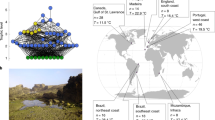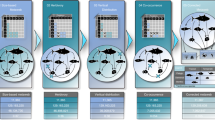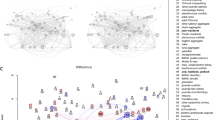Abstract
How real-world marine food webs absorb change, recover and adapt (that is, ecological resilience) to climate change remains problematic. Here we apply a novel approach to show how the complex changes in resilience of food webs can be understood with a small core set of self-organizing configurations that represent different simultaneously nested and multiple-species interactions. We identified a recent emergent pattern of an improving but possibly short-lived resilience of a highly observed Arctic marine food web (2004–2016), considered a harbinger of future Arctic change. The changes can be explained by continuing subsidiary inputs of Atlantic species that repair (self-organize) interactions within some configurations. Despite significant environmental perturbation, we found that the core ecological processes are maintained. We conclude that Arctic marine food webs can absorb and begin to adapt to ongoing climate change.
This is a preview of subscription content, access via your institution
Access options
Access Nature and 54 other Nature Portfolio journals
Get Nature+, our best-value online-access subscription
$29.99 / 30 days
cancel any time
Subscribe to this journal
Receive 12 print issues and online access
$209.00 per year
only $17.42 per issue
Buy this article
- Purchase on Springer Link
- Instant access to full article PDF
Prices may be subject to local taxes which are calculated during checkout




Similar content being viewed by others
Data availability
The data used during the study are available at the Norwegian Polar Data Centre https://doi.org/10.21334/npolar.2019.4a851dd2 or are available from the corresponding author on reasonable request.
Code availability
The software code for the ERGM models is available from https://www.melnet.org.au/pnet and http://cran.r-project.org/web/packages/Bergm.
References
Hagstrom, G. I. & Levin, S. A. Marine ecosystems as complex adaptive systems: emergent patterns, critical transitions, and public goods. Ecosystems 20, 458–476 (2017).
Box, J. E. Key indicators of Arctic climate change. Environ. Res. Lett. 14, 045010 (2019).
Fossheim, M. et al. Recent warming leads to a rapid borealization of fish communities in the Arctic. Nat. Clim. Change 5, 673–677 (2015).
Kortsch, K. et al. Climate change alters the structure of Arctic marine food webs due to poleward shifts of boreal generalists. Proc. R. Soc. B 282, 20151546 (2015).
AMAP Climate Change Update 2019: An Update to Key Findings of Snow, Water, Ice and Permafrost in the Arctic (SWIPA) 2017 (Arctic Monitoring and Assessment Programme, 2019).
Bischof, K. et al. in The Ecosystem of Kongsfjorden, Svalbard (eds Hop, H. & Wiencke, C.) 537–562 (Advances in Polar Ecology Vol 2, Springer, 2019).
Kortsch, K. et al. Climate-driven regime shifts in Arctic marine benthos. Proc. Natl Acad. Sci. USA 110, 14052–14057 (2012).
Carson, M. & Peterson, G. Arctic Resilience Report (Arctic Council, Stockholm Environment Institute and Stockholm Resilience Centre, 2016).
Levin, S. A. & Lubchenco, J. Resilience, robustness, and marine ecosystem-based management. Bioscience 58, 27–32 (2008).
Hop, H. & Wiencke, C. The Ecosystem of Kongsfjorden, Svalbard (Advances in Polar Ecology Vol. 2, Springer, 2019).
Lusher, D., Koskinen, J. & Robins, G. Exponential Random Graph Models for Social Networks. Theory, Methods and Applications (Cambridge Univ. Press, 2013).
Condie, S. A., Johnson, P., Fulton, E. A. & Bulman, C. M. Relating food web structure to resilience, keystone status and uncertainty in ecological responses. Ecosphere 5, 81 (2014).
Bascompte, J. & Melian, C. J. Simple trophic modules for complex food webs. Ecology 86, 2868–2873 (2005).
Stouffer, D. B. & Bascompte, J. Understanding food-web persistence from local to global scales. Ecol. Lett. 13, 154–161 (2010).
Caimo, A. & Friel, N. Bayesian inference for exponential random graph models. Soc. Networks 33, 41–55 (2010).
Yletyinen, J., Bodin, Ö., Weigel, B., Nordström, M. C., Bonsdoff, E. & Blencker, T. Regime shifts in marine communities: a complex systems perspective on food web dynamics. Proc. R. Soc. B 283, 20152569 (2017).
Planque, B. et al. Who eats whom in the Barents Sea: a food web topology from plankton to whales. Ecology 95, 1430 (2014).
Renner, A. H. H., Dodd, P. A. & Fransson, A. An Assessment of MOSJ: The State of the Marine Climate System around Svalbard and Jan Mayen (Norwegian Polar Institute, 2018).
Geyer, C. J. & Thompson, E. A. Constrained Monte Carlo maximum likelihood for dependent data (with discussion). J. R. Stat. Soc. B 54, 657–699 (1992).
Murray, I., Ghahramani, Z. & Mackay, D. in Proc. 22nd Annual Conference on Uncertainty in Artificial Intelligence (eds Dechter, R. & Richardson, T.) 359–366 (AUAI, 2006).
Jordán, F., Okey, T. A., Bauer., B. & Libralato, S. Identifying important species: linking structure and function in ecological networks. Ecol. Model. 216, 75–80 (2008).
Griffith, G. P., Strutton, P. G., Semmens, J. M. & Fulton, E. A. Identifying important species that amplify or mitigate the interaction effects of human impacts on marine food webs. Cons. Biol. 33, 403–412 (2019).
Camacho, J., Stouffer, D. & Amarel, L. Quantitative analysis of the local structure of food webs. J. Theor. Biol. 246, 260–268 (2007).
Vrkoč, I. & Křivan, V. Asymptotic stability of tri-trophic food chains sharing a common resource. Math. Biosci. 270, 90–94 (2015).
Holt, R. D. Predation, apparent competition, and the structure of prey communities. Theor. Popul. Biol. 12, 197–229 (1977).
Wiencke, C. & Hop, H. Ecosystem Kongsfjorden: new views after more than a decade of research. Polar Biol. 39, 1679–1687 (2016).
Descamps, S. et al. Climate change impacts on wildlife in a High Arctic archipelago—Svalbard, Norway. Glob. Change Biol. 23, 490–502 (2017).
Blanchard, J. A rewired food web. Nature 527, 173–175 (2015).
Tverberg, V. et al. in The Ecosystem of Kongsfjorden, Svalbard (eds Hop, H. & Wiencke, C.) 49–104 (Advances in Polar Ecology Vol. 2, Springer, 2019).
Scheffer, M. et al. Anticipating critical transitions. Science 338, 344–348 (2012).
Vihtakari, M. et al. Black-legged kittiwakes as messengers of Atlantification in the Arctic. Sci. Rep. 8, 1178 (2018).
Litzow, M. A. & Hunsicker, M. E. Early warning signals, nonlinearity, and signs of hysteresis in real ecosystems. Ecosphere 7, e01614 (2016).
May, R. M. Networks and webs in ecosystems and financial systems. Phil. Trans. R. Soc. A 371, 20120376 (2013).
Dalpadado, P. et al. Distribution and abundance of euphausiids and pelagic amphipods in Kongsfjorden, Isfjorden and Rijpfjorden (Svalbard) and changes in their relative importance as key prey in a warming marine ecosystem. Polar Biol. 39, 1765–1784 (2016).
Lydersen, C. et al. The importance of tidewater glaciers for marine mammals and seabirds in Svalbard, Norway. J. Mar. Syst. 129, 452–471 (2014).
Choquet, M. et al. Genetics redraws pelagic biogeography of Calanus. Biol. Lett. 13, 20170588 (2017).
Hamilton, C. D. et al. Spatial overlap among Arctic predators, prey and scavengers in the marginal ice zone. Mar. Ecol. Prog. Ser. 573, 45–59 (2017).
Huenerlage, K., Graeve, M. & Buchholz, F. Lipid composition and trophic relationships of krill species in a high Arctic fjord. Polar Biol. 39, 1803–1817 (2016).
Renaud, P. E. et al. Pelagic food-webs in a changing Arctic: a trait-based perspective suggests a mode of resilience. ICES J. Mar. Sci. 75, 1871–1881 (2018).
Acknowledgements
The authors acknowledge the support of the Research Council of Norway (Ice-algal and under-ice phytoplankton bloom dynamics in a changing Arctic icescape (Boom or Bust), project no. 244646), FRAM-High North Research Centre for Climate and Environment Flagship program Ocean acidification and ecosystem effects in Northern Waters, the Norwegian Metacentre for Computational Science (NOTUR) and the Norwegian Polar Institute’s Centre for Ice, Climate and Ecosystems (ICE).
Author information
Authors and Affiliations
Contributions
G.P.G. conceived the idea, methods and wrote the paper. All the co-authors contributed to the final version. G.P.G., H.H., G.W.G. and M.V. interpreted the results. M.V., K.K. and A.W. prepared the data.
Corresponding author
Ethics declarations
Competing interests
The authors declare no competing interests.
Additional information
Peer review information Nature Climate Change thanks Scott Condie, Johanna Yletyinen and the other, anonymous, reviewer(s) for their contribution to the peer review of this work.
Publisher’s note Springer Nature remains neutral with regard to jurisdictional claims in published maps and institutional affiliations.
Supplementary information
Supplementary Information
Supplementary Figs. 1–3, Tables 1–3 and references.
Rights and permissions
About this article
Cite this article
Griffith, G.P., Hop, H., Vihtakari, M. et al. Ecological resilience of Arctic marine food webs to climate change. Nat. Clim. Chang. 9, 868–872 (2019). https://doi.org/10.1038/s41558-019-0601-y
Received:
Accepted:
Published:
Issue Date:
DOI: https://doi.org/10.1038/s41558-019-0601-y
This article is cited by
-
Biogeographic gradients of picoplankton diversity indicate increasing dominance of prokaryotes in warmer Arctic fjords
Communications Biology (2024)
-
Energy content of krill and amphipods in the Barents Sea from summer to winter: variation across species and size
Polar Biology (2023)
-
The effects of ecological rehabilitation projects on the resilience of an extremely drought-prone desert riparian forest ecosystem in the Tarim River Basin, Xinjiang, China
Scientific Reports (2021)
-
Rare events in the Arctic
Climatic Change (2021)
-
Arctic climate resilience
Nature Climate Change (2019)



